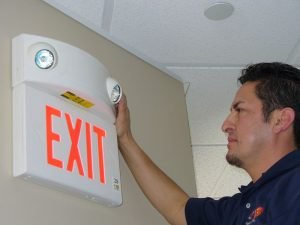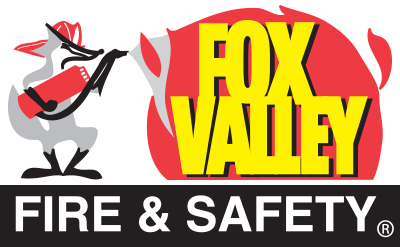Codes for Emergency Exit Lights/Exit Signs/Central Lighting Inverter Systems
Codes

NFPA 101 Life Safety Code Read more
NFPA 110 & 111 Stored Electrical Energy Emergency and Standby Power Systems Read more
NEC National Electrical Code – NFPA 70 Read more
International Fire Code Chapter 6 Building Services and Systems Read more
Chicago Electrical Code Read more
Chicago Municipal Code Read more
NFPA 101
What is NFPA 101?
The Life Safety Code is the most widely used source for strategies to protect people based on building construction, protection, and occupancy features that minimize the effects of fire and related hazards. Unique in the field, it is the only document that covers life safety in both new and existing structures.
What does NFPA 101 address?
Provisions are included for all types of occupancies, with requirements for egress, features of fire protection, sprinkler systems, alarms, emergency lighting, smoke barriers, and special hazard protection.
Official document scope
NFPA 101: DOCUMENT SCOPE
1.1* Scope. A.1.1 The following is a suggested procedure for determining the Code requirements for a building or structure: (1) Determine the occupancy classification by referring to the occupancy definitions in Chapter 6 and the occupancy Chapters 12 through 42. (See 6.1.14 for buildings with more than one use.) (2) Determine if the building or structure is new or existing. (See the definitions in Chapter 3.) (3) Determine the occupant load. (See 7.3.1.) (4) Determine the hazard of contents. (See Section 6.2.) (5) Refer to the applicable occupancy chapter of the Code, Chapters 12 through 42. [See Chapters 1 through 4 and Chapters 6 through 11, as needed, for general information (such as definitions) or as directed by the occupancy chapter.] (6) Determine the occupancy sub-classification or special use condition, if any, by referring to Chapters 16 and 17, daycare occupancies; Chapters 18 and 19, health care occupancies; Chapters 22 and 23, detention and correctional occupancies; Chapters 28 and 29, hotels and dormitories; Chapters 32 and 33, residential board and care occupancies; Chapters 36 and 37, mercantile occupancies; and Chapter 40, industrial occupancies, which contain sub-classifications or special use definitions. (7) Proceed through the applicable occupancy chapter to verify compliance with each referenced section, subsection, paragraph, subparagraph, and referenced codes, standards, and other documents. (8) Where two or more requirements apply, refer to the occupancy chapter, which generally takes precedence over the base Chapters 1 through 4 and Chapters 6 through 11. (9) Where two or more occupancy chapters apply, such as in a mixed occupancy (see 6.1.14), apply the most restrictive requirements. 1.1.1 Title. NFPA 101, Life Safety Code, shall be known as the Life Safety Code®, is cited as such, and shall be referred to herein as “this Code” or “the Code.” 1.1.2 Danger to Life from Fire. The Code addresses those construction, protection, and occupancy features necessary to minimize danger to life from the effects of fire, including smoke, heat, and toxic gases created during a fire. 1.1.3 Egress Facilities. The Code establishes minimum criteria for the design of egress facilities so as to allow prompt escape of occupants from buildings or, where desirable, into safe areas within buildings. 1.1.4 Other Fire-Related Considerations. The Code addresses other considerations that are essential to life safety in recognition of the fact that life safety is more than a matter of egress. The Code also addresses protective features and systems, building services, operating features, maintenance activities, and other provisions in recognition of the fact that achieving an acceptable degree of life safety depends on additional safeguards to provide adequate egress time or protection for people exposed to fire. 1.1.5* Considerations Not Related to Fire. The Code also addresses other considerations that, while important in fire conditions, provide an ongoing benefit in other conditions of use, including non-fire emergencies. A.1.1.5 Life safety in buildings includes more than safety from fire. Although fire safety has been the long-standing focus of NFPA 101, its widely known title, Life Safety Code, and its technical requirements respond to a wider range of concerns, including, for example, crowd safety. 1.1.6 Areas Not Addressed. The Code does not address the following: (1)*General fire prevention or building construction features that are normally a function of fire prevention codes and building codes A.1.1.6(1) This Code is intended to be adopted and used as part of a comprehensive program of building regulations that include building, mechanical, plumbing, electrical, fuel gas, fire prevention, and land use regulations. (2) Prevention of injury incurred by an individual due to that individual’s failure to use reasonable care (3) Preservation of property from loss by fire. Chapter 7 Means of Egress, 7.9.3 Periodic Testing of Emergency Lighting Equipment.
NFPA 101 Free access to the 2015 edition of NFPA 101
NFPA FAQs 4 page PDF
Fact Sheet on NFPA 101 1 page PDF
NFPA 110 & 111
Stored Electrical Energy Emergency and Standby Power Systems
NFPA 110 Standard for Emergency and Standby Power Systems
What is NFPA 110?
This standard covers performance requirements for emergency and standby power systems providing an alternate source of electrical power in buildings and facilities in the event that the normal electrical power source fails. Systems include power sources, transfer equipment, controls, supervisory equipment, and accessory equipment needed to supply electrical power to the selected circuits.
What does NFPA 110 address?
NFPA 110 presents installation, maintenance, operation, and testing requirements as they pertain to the performance of the emergency or standby power supply system (EPSS) up to the load terminals of the transfer switch. Specific topics include definitions of the classification of EPSS; energy sources, converters, inverters, and accessories; transfer switches and protection; installation and environmental considerations; and routine maintenance and operational testing.
Official Document Scope
NFPA 110: DOCUMENT SCOPE
1.1 Scope. This standard contains requirements covering the performance of emergency and standby power systems providing an alternate source of electrical power to loads in buildings and facilities in the event that the primary power source fails. 1.1.1 Power systems covered in this standard include power sources, transfer equipment, controls, supervisory equipment, and all related electrical and mechanical auxiliary and accessory equipment needed to supply electrical power to the load terminals of the transfer equipment. 1.1.2 This standard covers installation, maintenance, operation, and testing requirements as they pertain to the performance of the emergency power supply system (EPSS). 1.1.3 This standard does not cover the following: (1) Application of the EPSS (2) Emergency lighting unit equipment (3) Distribution wiring (4) Utility service when such service is permitted as the EPSS (5) Parameters for stored energy devices (6) The equipment of systems that are not classed as Level 1 or Level 2 systems in accordance with Chapter 4 of this standard 1.1.4* This standard does not establish criteria for stored energy systems. 1.1.5 The selection of any of the following is not within the scope of this standard: (1) Specific buildings or facilities, or both, requiring an EPSS (2) Specific loads to be served by the EPSS (3)*Assignment of type, class, or level to any specific load.
NFPA 110 Free access to the 2016 edition of NFPA 110
NFPA 111 Standard on Stored Electrical Energy Emergency and Standby Power Systems
What is NFPA 111?
This standard covers performance requirements for stored electrical energy systems providing an alternate source of electrical power in buildings and facilities in the event that the normal electrical power source fails. Systems include power sources, transfer equipment, controls, supervisory equipment, and accessory equipment needed to supply electrical power to the selected circuits.
What does NFPA 111 address?
NFPA 111 presents installation, maintenance, operation, and testing requirements as they pertain to the performance of the stored emergency power supply system (SEPSS) up to the load terminals of the transfer switch. Specific topics include definitions of the classification of SEPSS; energy sources, converters, inverters, and accessories; transfer switches and protection; installation and environmental considerations; and routine maintenance and operational testing.
Official Document Scope
NFPA 111: DOCUMENT SCOPE
1.1 Scope. 1.1.1* This standard shall cover performance requirements for stored electrical energy systems providing an alternate source of electrical power in buildings and facilities in the event that the normal electrical power source fails. A.1.1.1 For emergency power systems supplied by emergency generators, see NFPA 110, Standard for Emergency and Standby Power Systems. 1.1.2 Systems covered in this standard shall include power sources, transfer equipment, controls, supervisory equipment, and accessory equipment, including integral accessory equipment, needed to supply electrical power to the selected circuits. 1.1.3 This standard shall cover installation, maintenance, operation, and testing requirements as they pertain to the performance of the stored emergency power supply system (SEPSS). 1.1.4 Exclusions. 1.1.4.1 This standard shall not cover the following: (1) Application of the SEPSS (2) Distribution wiring (3) Systems having total outputs less than 500 VA or less than 24 V, or systems less than Class 0.033 (4) Unit equipment (5) Nuclear sources, solar systems, and wind stored-energy systems (6) Uninterruptible power systems (UPS) supplied by an emergency power supply system (EPSS) 1.1.4.2 The following shall not be within the scope of this standard: (1) Specific buildings or facilities, or both, requiring an SEPSS (2) Specific loads to be served by the SEPSS (3) Type, class, or level to be assigned to any specific load (See Section 4.1.)
NFPA 111 Free access to the 2016 edition of NFPA 111
NEC National Electrical Code – NFPA 70
What is NFPA 70?
Adopted in all 50 states, the NEC is the benchmark for safe electrical design, installation, and inspection to protect people and property from electrical hazards.
What does NFPA 70 address?
The NEC addresses the installation of electrical conductors, equipment, and raceways; signaling and communications conductors, equipment, and raceways; and optical fiber cables and raceways in commercial, residential, and industrial occupancies.
Official Document Scope:
NFPA 70: DOCUMENT SCOPE
90.2 Scope. (A) Covered. This Code covers the installation and removal of electrical conductors, equipment, and raceways; signaling and communications conductors, equipment, and raceways; and optical fiber cables and raceways for the following: (1) Public and private premises, including buildings, structures, mobile homes, recreational vehicles, and floating buildings, (2) Yards, lots, parking lots, carnivals, and industrial substations, (3) Installations of conductors and equipment that connect to the supply of electricity, (4) Installations used by the electric utility, such as office buildings, warehouses, garages, machine shops, and recreational buildings, that are not an integral part of a generating plant, substation, or control center.
(B) Not Covered. This Code does not cover the following: (1) Installations in ships, watercraft other than floating buildings, railway rolling stock, aircraft, or automotive vehicles other than mobile homes and recreational vehicles. Informational Note: Although the scope of this Code indicates that the Code does not cover installations in ships, portions of this Code are incorporated by reference into Title 46, Code of Federal Regulations, Parts 110–113. (2) Installations underground in mines and self-propelled mobile surface mining machinery and its attendant electrical trailing cable, (3) Installations of railways for generation, transformation, transmission, energy storage, or distribution of power used exclusively for operation of rolling stock or installations used exclusively for signaling and communications purposes, (4) Installations of communications equipment under the exclusive control of communications utilities located outdoors or in building spaces used exclusively for such installations, (5) Installations under the exclusive control of an electric utility where such installations: a. Consist of service drops or service laterals, and associated metering, or b. Are on property owned or leased by the electric utility for the purpose of communications, metering, generation, control, transformation, transmission, energy storage, or distribution of electric energy, or c. Are located in legally established easements or rights-of-way, or d. Are located by other written agreements either designated by or recognized by public service commissions, utility commissions, or other regulatory agencies having jurisdiction for such installations. These written agreements shall be limited to installations for the purpose of communications, metering, generation, control, transformation, transmission, energy storage, or distribution of electric energy where legally established easements or rights-of-way cannot be obtained. These installations shall be limited to federal lands, Native American reservations through the U.S. Department of the Interior Bureau of Indian Affairs, military bases, lands controlled by port authorities and state agencies and departments, and lands owned by railroads. Informational Note to (4) and (5): Examples of utilities may include those entities that are typically designated or recognized by governmental law or regulation by public service/utility commissions and that install, operate, and maintain electric supply (such as generation, transmission, or distribution systems) or communications systems (such as telephone, CATV, Internet, satellite, or data services). Utilities may be subject to compliance with codes and standards covering their regulated activities as adopted under governmental law or regulation. Additional information can be found through consultation with the appropriate governmental bodies, such as state regulatory commissions, the Federal Energy Regulatory Commission, and the Federal Communications Commission.
(C) Special Permission. The authority having jurisdiction for enforcing this Code may grant exception for the installation of conductors and equipment that are not under the exclusive control of the electric utilities and are used to connect the electric utility supply system to the service conductors of the premises served, provided such installations are outside a building or structure, or terminate inside at a readily accessible location nearest the point of entrance of the service conductors.
NFPA 70 Free access to the 2017 edition of NFPA 70
International Fire Code
Chapter 6 Building Services and Systems – Section 604 Emergency and Standby Power Systems
604.6 Emergency lighting equipment. Emergency lighting shall be inspected and tested in accordance with Sections 604.6.1 through 604.6.2.1.
604.6.1 Activation test. An activation test of the emergency lighting equipment shall be completed monthly. The activation test shall ensure the emergency lighting activates automatically upon normal electrical disconnect and stays sufficiently illuminated for a minimum of 30 seconds.
604.6.1.1 Activation test record. Records shall be maintained on the premises. The record shall include the location of the emergency lighting tested, whether the unit passed or failed, the date of the test, and the person completing the test.
604.6.2 Power test. For battery-powered emergency lighting, a power test of the emergency lighting equipment shall be completed annually. The power test shall operate the emergency lighting for a minimum of 90 minutes and shall remain sufficiently illuminated for the duration of the test.
604.6.2.1 Power test record. Records shall be maintained on the premises. The record shall include the location of the emergency lighting tested, whether the unit passed or failed, the date of the test, and the person completing the test.
604.7 Supervision of maintenance and testing. Routine maintenance, inspection and operational testing shall be overseen by a properly instructed individual.
International Fire Code 2015 Public Access
Chicago Electrical Code
LOCAL and/or State law may require adherence to either the NEC or some other electrical code. For example, in Chicago, the provisions of Article 700 of NFPA 70 are not adopted. The following language is adopted as Article 700:
“700 Emergency Systems
Part I. General
700.1.Scope. The purpose of this article is to provide details for installation of required exit and emergency illumination systems in all buildings, new and existing.
The provisions of Article 700 are intended to provide a reasonably reliable alternate source of electrical power upon the failure of the normal source of supply. It is impossible to list all of the various means of accomplishing the desired results. Article 700 is intended to set a minimum standard for such installations.
Chicago Electrical Code
Chicago Municipal Code
13-20-020 Buildings – Inspection required.
(a) Subject to subsection (b) of this section, the fire commissioner or the buildings commissioner and their respective assistants shall make an annual inspection of all theaters, churches, schools, public assembly units, public places of amusement and open air assembly units; and also all buildings over one story in height, except single dwellings, multiple-use buildings consisting of business and dwelling units two stories or less in height, and multiple dwellings three stories or less in height, unless such multiple dwellings are lodging or rooming houses with sleeping accommodations for 20 or more persons. With respect to any establishment requiring a public place of amusement license, the fire commissioner or the buildings commissioner and their respective assistants shall make an inspection within the 90 days preceding the deadline for the annual renewal application for the license. It shall be the duty of every owner, agent, lessee, or occupant of any such building and of the person in charge or control of the same to permit the making of such annual inspection by the fire commissioner, or by the building commissioner or by a duly authorized inspector at any time upon demand being duly made.
(b) Inspections by the buildings commissioner of places for eating, as that term is defined in Section 4-8-010, shall be controlled by Section 4-8-042; provided that nothing in this section shall be construed to limit inspections of any place for eating by the fire commissioner.
13-160 Buildings – Exit Requirements 13-160-660 thru 13-160-790
Exit Lighting, Emergency Lighting, Exit, Stairway, Fire Escape and Directional Signs, Enforcement of Sections 13-160-710 through 13-160-770
Chicago Municipal Code




